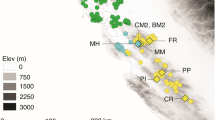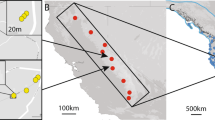Abstract
Gene flow, the movement or dispersal of genes within or among populations, is a crucial factor in determining the structure and cohesiveness of species and populations. Spatial restriction of gene flow can lead to non-random mating and to subdivision of a population into genetic neighbourhoods. On the other hand, extensive gene flow over large geographical areas can overshadow the influence of selection, leading to genetic similarity among populations and increased uniformity within a species. The extent and magnitude of actual gene flow are thus relevant to a broad range of disciplines. While the central role of gene flow is widely recognised, actual measurements of gene flow in either plants or animals are few. In plants gene flow can occur via seed or pollen dispersal. Levels of gene flow due to pollen dispersal have usually been inferred, either by marking pollen with a chemical or radioactive label for wind pollinated species or by determining the distribution of pollinator foraging flight distances for insect-pollinated species. Measurements of gene flow via pollen movement in plants have been limited to studies of a few agricultural species, where the minimum separation distance required to isolate stocks genetically was of interest1,2. Here I report the measurement of the pollen component of gene flow in the insect-pollinated species, Lupinus texensis, compare the actual gene flow distribution with the distribution inferred from pollinator flight movements, and finally, determine the genetic neighbourhood size of this species from the pollen and seed dispersal distributions. Actual gene flow via pollen is found to be greater than would be inferred from pollinator movement alone. Gene flow and neighbourhood size are nevertheless very restricted.
This is a preview of subscription content, access via your institution
Access options
Subscribe to this journal
Receive 51 print issues and online access
$199.00 per year
only $3.90 per issue
Buy this article
- Purchase on Springer Link
- Instant access to full article PDF
Prices may be subject to local taxes which are calculated during checkout
Similar content being viewed by others
References
Bateman, A. Heredity 1, 303–336 (1947).
Griffiths, D. J. agric. Sci. 40, 19–38 (1950).
Wright, S. Genetics 31, 39–50 (1946).
Levin, D. & Kerster, H. Am. Nat. 105, 345–354 (1971).
Wright, S. Proc. Am. phil. Soc. 93, 471–478 (1949).
Gregorius, H. Theor. Population Biol. 8, 134–142 (1976).
Author information
Authors and Affiliations
Rights and permissions
About this article
Cite this article
Schaal, B. Measurement of gene flow in Lupinus texensis. Nature 284, 450–451 (1980). https://doi.org/10.1038/284450a0
Received:
Accepted:
Issue Date:
DOI: https://doi.org/10.1038/284450a0
This article is cited by
-
Genetic diversity and differentiation of the Hainan Tall coconut (Cocos nucifera L.) as revealed by inter-simple sequence repeat markers
Genetic Resources and Crop Evolution (2018)
-
Cryptic genetic subdivision in the San Benito evening primrose (Camissonia benitensis)
Conservation Genetics (2014)
-
Effects of self-pollination and maternal resources on reproduction and offspring performance in the wild lupine, Lupinus perennis (Fabaceae)
Sexual Plant Reproduction (2005)
-
Spatial autocorrelation within a korean population ofRaphanus sativus var.hortensis f.raphanstroides
Journal of Plant Biology (1999)
-
Primary measurement of pollen flow inLiriodendron chinense using RAPD markers
Chinese Science Bulletin (1998)
Comments
By submitting a comment you agree to abide by our Terms and Community Guidelines. If you find something abusive or that does not comply with our terms or guidelines please flag it as inappropriate.



